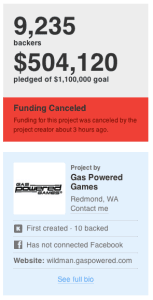These tips were compiled by Ella van Leeuwen, Margit Laurs and Melvin Loggies, Master students Entrepreneurship & New Business Venturing at the Rotterdam School of Management (Erasmus University), Rotterdam, the Netherlands. Content shared in partnership with Symbid.
Lesson 6: Keep communicating!
 “The more transparent, the better. Not only in terms of figures but also in terms of identity”. This quote by Martijn van Schelven of Geldvoorelkaar lays the foundation of the sixth lesson. As illustrated by the previous lessons, it is important to communicate with your (potential) investors when starting a crowdfunding campaign. In addition to the promotion, it is important to have extensive contact with your investors. In this way you can prevent being a mystery towards your investors and forge early and strong relationships with them as customers. First of all, it is important to communicate your goals to the investors. Express your financial aim and explain which Euro will be spent on what business activity.
“The more transparent, the better. Not only in terms of figures but also in terms of identity”. This quote by Martijn van Schelven of Geldvoorelkaar lays the foundation of the sixth lesson. As illustrated by the previous lessons, it is important to communicate with your (potential) investors when starting a crowdfunding campaign. In addition to the promotion, it is important to have extensive contact with your investors. In this way you can prevent being a mystery towards your investors and forge early and strong relationships with them as customers. First of all, it is important to communicate your goals to the investors. Express your financial aim and explain which Euro will be spent on what business activity.
Secondly, it is essential for you, being an entrepreneur, to open up and show the investors who the person behind this crowdfunding campaign is. Who are you, what is your story and where are you from? According to Martijn van Schelven from Geldvoorelkaar it is important to find the right tone of voice by using movies, pictures, and descriptions. For example, if you aim to attract businesses, the style and content of your communication must have a different tone of voice than when attracting your individual investors. Last but not least, it is crucial to update the investors at all times; not only during the crowdfunding campaign, but also after its completion. You must regularly provide updates to the investors about the progress of the crowdfunding campaign. For example when you have reached 30% of your target capital or have 100 investors. Tetsuro Miyazaki from KRNWTR found that considerably more investments where placed right after an update was posted on the crowdfunding platform Oneplanetcrowd. It is equally important to give updates after the completion of the campaign, including financial statements. How are you doing and how is the execution of the project getting along? Martijn Arets from Brand Expedition acknowledges the importance of regularly posting these follow-up updates. “I post an update every 6 weeks, although I think that is not enough”. According to Martijn, investors really like to know what exactly is done with their investments and what is coming next.
In the next lesson we will focus on creating a back-up plan. It will emphasize the importance of being realistic when running a crowdfuding campaign. The objective is to help you create alternative plans for the unfortunate situation where your target capital will not be reached within the time range.
Lesson 7: The back-up plan
 When the previous lessons have convinced you that crowdfunding is the way to go for your project and you eventually decide to launch your crowdfunding campaign, make sure you have evaluated several alternatives in terms of failure. Of course you start a crowdfunding campaign with the aim to become very successful, however, in the end it might not run as smoothly as predicted. Even though you are 100% focused on the crowdfunding campaign, you must be realistic and create a back-up plan for the unfortunate situation where the target capital will not be reached within the time range.
When the previous lessons have convinced you that crowdfunding is the way to go for your project and you eventually decide to launch your crowdfunding campaign, make sure you have evaluated several alternatives in terms of failure. Of course you start a crowdfunding campaign with the aim to become very successful, however, in the end it might not run as smoothly as predicted. Even though you are 100% focused on the crowdfunding campaign, you must be realistic and create a back-up plan for the unfortunate situation where the target capital will not be reached within the time range.
Robert de Waal from Biogolf and Tetsuro Miyazaki from KRNWTR, were both willing to chip in the remaining amount of money if needed. Another solution, as proposed by Robert de Waal, might be to ask your direct relations to invest the final amount of money or to make the rewards you offer more appealing. For example, increasing the return on investment might be a way to make it more appealing for investors. Robin Slakhorst from Symbid suggests that in some scenarios an entrepreneur can decide to extend the time period. However, on the other hand he argues that if the campaign does not succeed within the given amount of time, it will probably never succeed after all.
It can occur that even your back-up plan is one step too far, and that you are better off terminating the campaign. It is key to be realistic and be honest to yourself. Tetsuro Miyazaki from KRNWTR made realistic decisions before the launch of his crowdfunding campaign regarding a potential failure. “A lack of investors would have implied that our project [KRNWTR App] was not viable. There for we would not have launched our app”. In order to maintain the trust of your investors, it might be wise to pull the plug. To contradict Tetsuro Miyazaki, you can decide to start over. This could be in terms of a new, differently executed crowdfunding campaign, or by the means of other financing alternatives. Whatever your back-up plan will be, make it a vial part of your whole master plan. And speaking about making a master plan, the ins and outs of it will be explained in the final lesson, the bonus lesson.
Bonus lesson: Make a master plan!
 When having read all the seven lessons in the previous weeks, there is one more thing to do in order to make your crowdfunding project a real success: Make a master plan! This is not just a standardized plan; this is a strategic plan you have to customize according to your needs and implications of the seven lessons. And to be honest, the seven lessons won’t be nearly as effective as with a well-thought strategic plan. In your customized master plan you have to set clearly how you’re going to involve your friends and family, who will be your target audience, how you will reward their financial and promotional support, how you will promote the project and communicate with your potential investors, and so on.
When having read all the seven lessons in the previous weeks, there is one more thing to do in order to make your crowdfunding project a real success: Make a master plan! This is not just a standardized plan; this is a strategic plan you have to customize according to your needs and implications of the seven lessons. And to be honest, the seven lessons won’t be nearly as effective as with a well-thought strategic plan. In your customized master plan you have to set clearly how you’re going to involve your friends and family, who will be your target audience, how you will reward their financial and promotional support, how you will promote the project and communicate with your potential investors, and so on.
You need to have a strategic plan to let potential investors experience your ideas to make this crowdfunding project a success in all its glory. An important aspect of this is that your plan needs to have a time frame, with a forecasted schedule for your efforts and for your achievements. A good example of this is Martijn Arets from Brand Expedition, and his plan towards his promotional efforts. To promote his crowdfunding campaign he symbolically brought the first stocks as a reward for his investors to the stock exchange on a carrier cycle decorated with balloons. Even Business News Radio (BNR) gave attention to his promotional stunt, but as Martijn Arets states: ‘’the timing wasn’t right, If I did this promotional stunt in a later stage, it would have had a bigger impact’’. This indicates that the timing of all your efforts is important. Some crowdfunding platforms offer you the opportunity to once make use of their network to promote your crowdfunding campaign. For example, Symbid offers a spot on their homepage and attention through their Facebook and mailing. They advice the entrepreneurs to time these promotional tools strategically, which will be during a drop in investors.
When this is going to be your first crowdfunding project, or if strategic planning is not your cup of tea, it might be useful to receive help from experienced crowdfunding entrepreneurs or crowdfunding consultants. Crowdfunding platforms can give you advice and guide you during the whole process. Additionally learning from successful and not so successful crowdfunding campaigns can help you a lot. But probably the best way to strategically plan your campaign is with the help of crowdfunding consultants, as ‘’crowdfunding consultants customize your whole strategic plan to your needs and that of your potential investors, and this will get the most out of your project’’, as stated by Robert de Waal from Biogolf. Douw&Koren is a crowdfunding consultancy company that works with useful tools that can fully be customized according to your needs, such as a ‘Crowdfunding Canvas’ and a ‘Plan de Campagne’ helped Robert.
Whether you make your master plan by yourself or with the help of experts, the trick is to be flexible and adapt to the rollercoaster effects of your campaign. Stefan Vreugdenburg of restaurant Blauw increased the rent on the investments from 7% to 10% when €16,000 was invested in one week, resulting in €109,000 of investments in just one day! This example shows that flexibility and adaptability are key. So make your master plan according to the seven lessons, use expert help, and stay flexible to make your crowdfunding campaign a stunning success.

